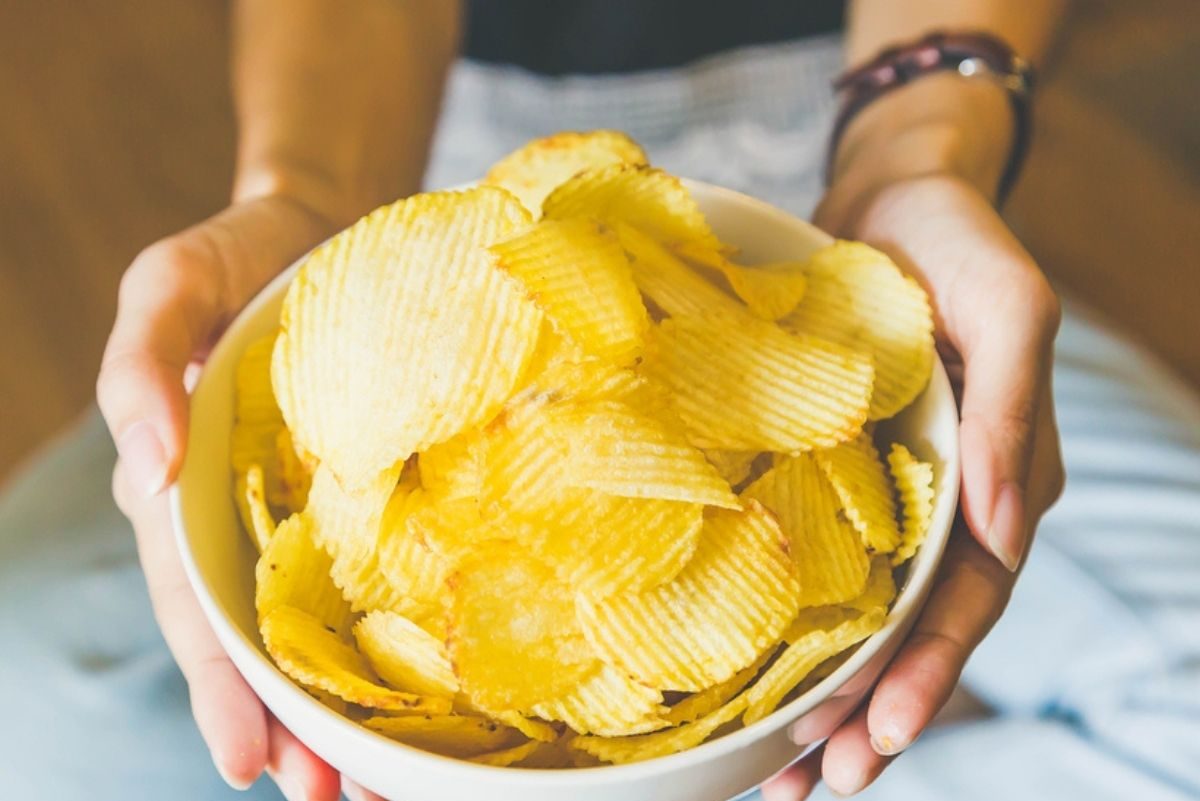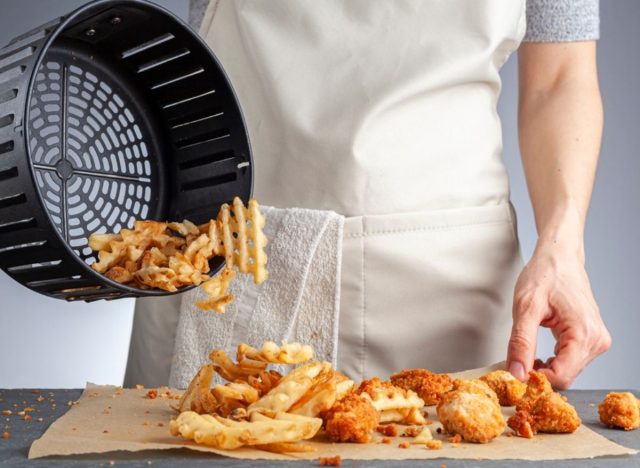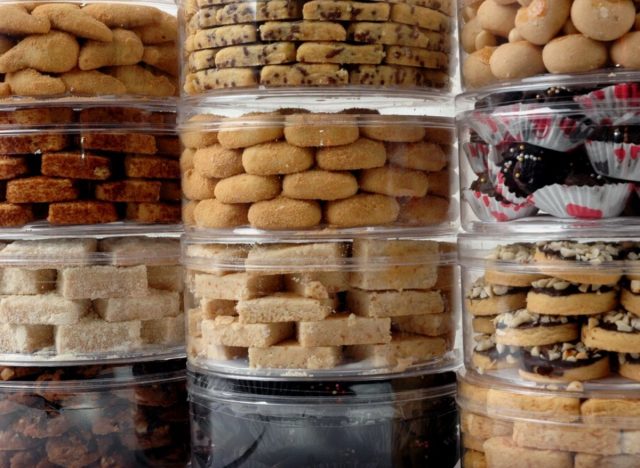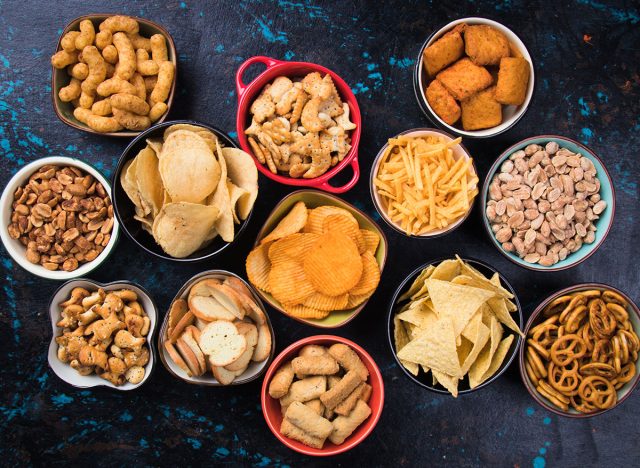5 Worst Foods for Blood Circulation, Say Dietitians

Maintaining proper blood circulation may not be at the top of your priorities, but the truth is, it's one of the best things you can do for your overall health.
"Circulation involves sending blood, oxygen, and nutrients to all parts of the body, removing waste products, regulating body temperature, and providing for muscle movement and tissue repair," explains Janet Coleman, RD, founder of TheConsumerMag. "When blood flow is restricted or blocked in any part of the body, it can cause problems in other areas. For example, poor circulation in the legs can cause varicose veins and ulcers on the feet. Poor circulation in the arms can make it difficult to use your hands. Poor circulation in the brain may lead to a stroke."
The good news is that you have more control over your circulation than you might realize.
"Your diet plays a major role in keeping your blood flowing smoothly because it provides all of the nutrients needed to keep your heart beating at an optimal rate and your arteries clear," adds Coleman.
According to Nataly Komova, RD, a fitness expert at JustCBD, consuming a lot of foods that are high in sodium, saturated fat, and added sugar can cause a build-up of plaque or narrowing of blood vessels due to increased cholesterol levels. So, as a general rule, you're better off choosing whole foods than processed ones.
With that in mind, dietitians say you should definitely skip the following foods, which can seriously hinder healthy blood circulation. And while we're on the subject, consider swapping those with the 5 Best Foods to Help Blood Circulation.
Fried foods

Trans fats are known as the worst possible kind of dietary fats for your health. In fact, studies have linked consumption of these fats to higher LDL (bad) cholesterol and lower HDL (good) cholesterol, chronic inflammation, heart disease, cancer, and diabetes. While the Food and Drug Administration (FDA) banned these fats back in 2018, some foods still contain some trans fat — often as a result of the cooking method used. For example, the heat applied to vegetable oils during the frying process can create trans fats — and each time the oil is reused to fry more food, the trans fat content increases.
So, what does this have to do with blood circulation?
"Eating foods high in these trans fats and saturated fats can spike up the level of bad cholesterol, which then leads to accumulation and deposition of fats on the blood vessels, interfering with smooth blood circulation," explains Komova.
Plus, breaded fried foods are often chock full of salt. Consuming too much sodium causes your body to retain water, which in turn elevates your blood pressure, says Coleman.
"High blood pressure can cause circulation problems and heart disease, which leads to poor circulation," she explains.
Since it's hard to know just how much trans fat is in a serving of French fries, chicken tenders, or mozzarella sticks, consider sticking with foods that are roasted, steamed, grilled, or sautéed.
Packaged pastries, cakes, and cookies

You're much better off baking your own cookies, muffins, and cakes at home than buying pre-packaged options at the store. Not only will the homemade version lack preservatives, but you can also have more control over how much sugar and fat is added to the recipe.
"Ultra-processed foods that are high in sugar raise triglyceride levels," says Dana Ellis Hunnes, PhD, RD, a senior clinical dietitian at UCLA medical center and author of Recipe For Survival.
Eating too much sugar can contribute to inflammation by releasing high amounts of insulin, and research has proven that chronic inflammation is associated with the development of type 2 diabetes. Diabetes involves having chronically high levels of glucose (sugar) in the blood, which then coats the veins and arteries and hinders them from working properly. As a result, many people with diabetes end up having circulation-related complications.
"High-sugar foods can damage the lining of the small blood vessels, thus affecting circulation," says Catherine Gervacio, RD, a dietitian for Living.Fit. "Over time, this results in harder, more narrow vessels, which disrupts blood flow."
Another issue with packaged pastries and desserts is that they may be high in saturated fat — for instance, from butter or coconut oil. Studies have shown that saturated fat can cause a build-up of fatty plaques on the inside of artery walls. This condition, known as atherosclerosis, can eventually cause the artery walls to harden. When this happens, it can limit blood flow to the heart.
Bacon

We hate to be the bearer of bad news, but bacon is definitely one of the worst foods you could add to your breakfast plate when it comes to your blood circulation — and there are several reasons for this.
For one, bacon is loaded with sodium — just two slices contain 420 milligrams.
Not only that, but bacon is high in saturated fat, which increases your LDL cholesterol levels — and high LDL cholesterol can lead to atherosclerosis and clog your blood vessels.
Like many other types of processed meat (including hot dogs and deli meat), a lot of bacon is high in nitrates, a type of chemical preservatives that may increase your risk of atherosclerosis. While you can specifically seek out nitrate-free bacon, all bacon still tends to be high in sodium and saturated fat.
Packaged salty snacks

Before you reach for that bag of chips, pretzels popcorn, or cheese puffs, consider this: these types of processed snacks often offer a double whammy of salt and saturated fat, which is bad news for your blood flow.
"Salty foods can increase blood pressure and make us potentially more prone to myocardial infarction or stroke, both of which are not good for circulation," explains Hunnes.
"Excessive sodium intake is associated with damage to the innermost layer of the blood vessels," adds Gervacio. "This thin sheet is important to keep the blood vessels dilated to increase blood flow."
As previously mentioned, saturated fat can increase LDL cholesterol, which is known to deposit plaque inside artery walls that causes them to narrow—and that obviously obstructs blood flow.
Pizza

Pizza may make for a tasty and convenient meal, but it certainly isn't doing your blood circulation any favors: A single slice can pack anywhere from 600 to 1,500 milligrams of sodium—up to half or more of your daily recommended limit of 2,300 milligrams. Frozen pizzas, in particular, tend to be brimming with excess salt.
On top of being high in sodium, cheese is also high in saturated fat, which can compromise blood flow and contribute to an accumulating plaque in the arteries. Add on cured meat toppings like pepperoni, sausage, or prosciutto this is even more of an issue for blood flow.
When you're really craving pizza, try making your own at home. That way, you can limit the sodium content by adding minimal cheese, as well as using vegetable toppings instead of nitrate- and saturated fat-containing meat options.









